Iceland’s Climate: An Overview
If you ask an Icelander what the weather’s like today, they’ll likely answer with a smirk and a shrug, or simply stand in amazement when the yellow thing in the sky appears. The truth? Iceland doesn’t have weather, it has moods, and they change faster than a toddler’s temperament during the bedtime routine (naming no names).
Iceland sits right where the warm Gulf Stream meets Arctic air, so its climate is a perpetual dance between mild maritime breezes and icy northern tundra weather. Despite the name, Iceland is not as cold as people expect. Reykjavík, for example, averages around 0°C in winter and 10°C+ in summer. In fact, the day before I started writing this guide, I regrettably got myself sunburnt….in Reykjavík. So, it can happen.
But don’t let those numbers fool you. The wind chill can humble even the most prepared outdoorsy types. Fortunately for you, by opening this guide, you are already halfway to being prepared.
Why Iceland’s Weather is So Unpredictable
Weather in Iceland is the master of surprise. But, don’t worry, it can only ruin your trip if you let it dampen your attitude (something I regularly remind myself of when walking in a storm).
You might wake up to glorious sunshine, get rained on while sipping a coffee, experience a fog so thick you lose sight of your campervan, and then see a rainbow by a waterfall like Skógafoss before lunch.
This is all thanks to the rapid movement of Atlantic weather systems that sweep over the island like they’re late for a meeting, which is also a common accomplishment for almost all Icelanders.
In short, expect everything. And dress like you’re going on a blind date with Mother Nature: cautiously layered. I cannot say ‘layered’ enough.
Regional Weather Variations: North, South, Highlands & Coast

South Iceland tends to be wetter and windier thanks to its open exposure to Atlantic systems.
The North, in contrast, often gets more stable weather in summer and colder, snowier winters. You’ll be enjoying a beer on the edge of Eyjafjörður fjord, spotting Humpbacks in summer, and digging your car out of morning snow in winter.
The Highlands are an entirely different beast of their own: dramatic, harsh, and only accessible in summer. Winter snow can linger until June, and can quickly come in with limited warning if you’re hiking at higher altitudes, in particular.
Coastal regions are breezy, misty, and home to some of the most dramatic skies you’ll likely ever photograph. You’ll get used to it as you explore, but largely speaking, where there are mountains, there is almost always unpredictable wind, so don’t let go of your camper wheel.
Take advantage of our itineraries to plan for the region you’re heading to, and always check the weather forecast before heading out. And, remember, Iceland is a bucket list adventure, so a little brisk weather here and there is part of the story. My main advice is to be prepared, but embrace it for the fun it is!
Iceland Weather by Season
Each season in Iceland brings its own brand of…I’m going to say uniqueness and delight. From snow-laced volcanoes to midnight sun black sand beach walks, timing your trip is always bit of a gamble. Pick the right season and it might treat you to a rainbow over a glacier. Pick the wrong one and it might ghost you behind a wall of fog or a whiteout as you navigate one of our many mountain passes.
But fear not. With the right camper and some flexible planning, every season is a chance to experience Iceland in full cinematic glory.
Winter (Dec–Feb): Storms, Snow & Northern Lights
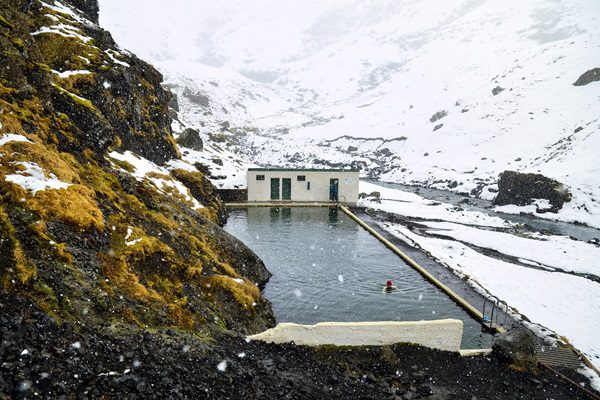
Winter in Iceland is dark, snowy, dark, dark, and wildly photogenic. Snow blankets the landscape. The roads regularly ice over (don’t worry, our studded tyres have you covered). And, of course, the delightful wind whispers sweet threats in your ear.
But here’s the main reason why travellers still come at this wildly dark, snowy, and unpredictable time of year: it’s also the best time to chase the Northern Lights from your campervan.
You don’t necessarily need a winter-ready Happy 4×4, but in my experience, it offers travellers peace of mind…as well as heating, studded tyres, and access to all of the best bits of Iceland (except the Highlands, which is closed off in winter).
Also, short days (sometimes only four hours of daylight) usually mean less driving, unless you’re chasing the lights every evening (which I’d highly recommend you do as each nights display is different to the last).
Spring (Mar–May): Thawing Trails & Shoulder Season Perks
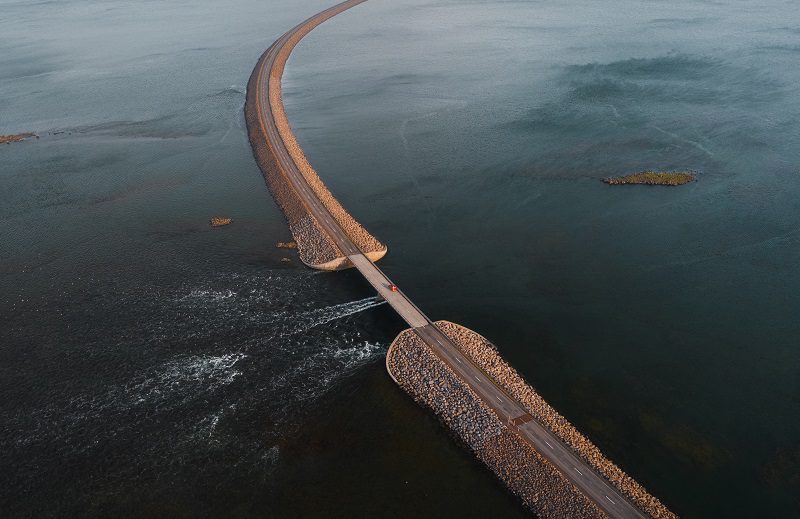
Spring is the great awakening.
The snow starts to melt, the roads reopen, and the country slowly thaws out from hibernation. The latter basically means that Icelanders generally become more chirpy in spring.
You’ll get fewer crowds, cheaper campervan rentals, and a chance to see both wintry peaks and blooming valleys in one shot. And, if you’re coming in March and still want to see the Northern Lights, due to the Russell-McPherron effect, it can actually provide better displays.
Road trip guides for spring can help you navigate weather-related closures while still soaking up the scenery.
Summer (Jun–Aug): Midnight Sun & Peak Road Trip Season
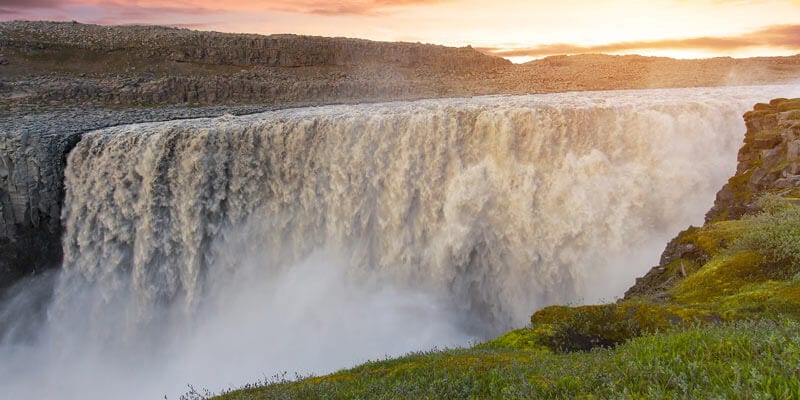
This is Iceland’s main event and peak season.
There’s light 24/7 (well, not sunlight 24/7, but almost), the F-roads to the Highlands open, and you’ll feel like you’re part of an endless golden hour with the crazy daylight hours offering great attraction photography opportunities all through the day and night.
It’s perfect for hiking, camping, puffin spotting, and exploring those hidden waterfalls your mate Dave said don’t exist.
With your campervan, you can dodge peak crowds by simply driving late and sleeping in. Genius. Summer is basically the opposite of winter, with no Northern Lights, very low chance of snow (but not impossible, as I was in a flurry the other week in June), and endless opportunities to keep on exploring.
Autumn (Sep–Nov): Moody Skies & Quieter Roads
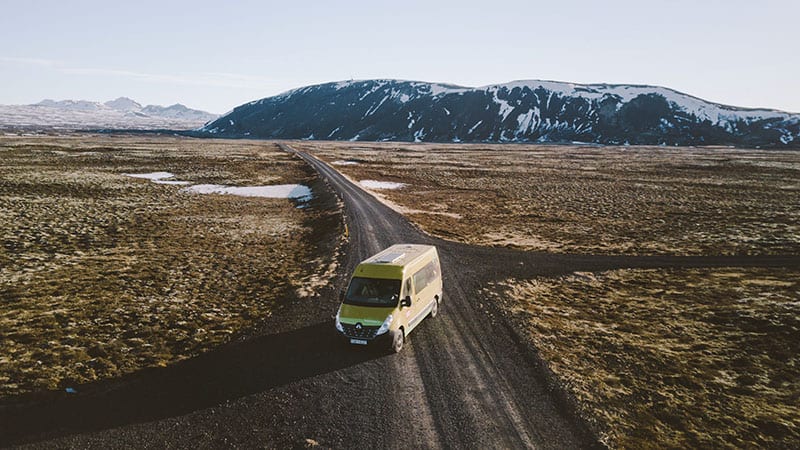
Autumn is often seen as sarcastic in Iceland. It only seems to last a week before transitioning into full-on winter.
Leaves turn, skies get broody, and the campervan crowds start to thin whilst the temperatures head back down.
However, Autumn is an awesome season to visit with lower prices and fewer crowds. Waterfalls continue to rage, mist clings to lava fields, and you’ll catch early aurora shows before the snow comes.
Bring your rain jacket and an appreciation for epic skies.
Weather Extremes: Rain, Wind & Daylight
If you thought Iceland might ease you in with a calm breeze or a light drizzle, think again. This is a place where the elements do as they please, often all at once. The weather here doesn’t dabble in subtlety. It goes big, it goes bold, and it has no shame about gatecrashing your plans, forcing even the most diligent of planners to embrace the enemy of spontaneity.
Extreme weather isn’t a bug in the Icelandic system. Instead, it’s a feature. And knowing how to expect the unexpected is the ultimate secret to thriving on your campervan adventure.
Iceland’s Fierce Winds and Sudden Storms
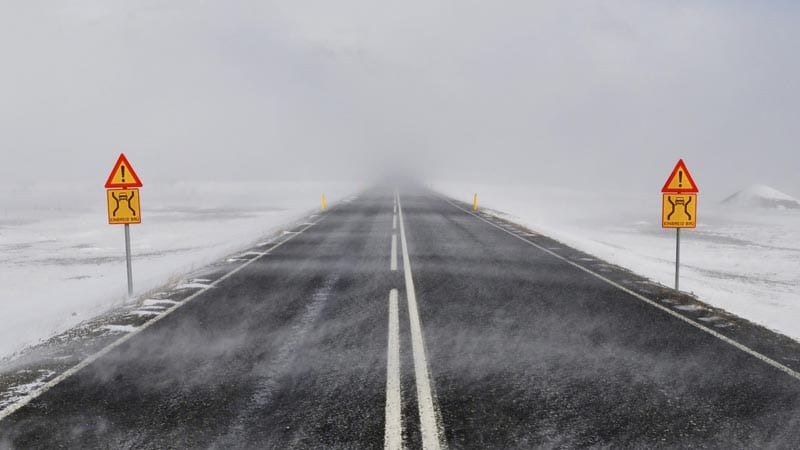
Let’s just say Iceland’s wind doesn’t whistle (at least for the most part). It slaps. It hurls. It sometimes lights up all of the colours of the traffic lights with the numerous weather warnings.
Use both hands when opening the campervan doors if you’re caught in one of these Poseidon-esque storms, and park into the wind if possible.
We cover storm driving tips in our Happy Safety Guide. Though it’s usually most common to experience the most frequent and intense storms in winter, in Iceland, I’m not joking when I say it can happen at any point. It’s a crazy latitude after all.
Rainfall and Misty Days
The South of Iceland tends to get a lot more rain on average. The East and North, less so.
But rain in Iceland isn’t always dramatic. Sometimes it’s a persistent mist that clings to everything from mountainsides to attractions such as the Reynisdrangar sea stacks, and it will feel like it does to your camper on some mornings.
Pack fast-drying clothes, waterproof layers, and good sturdy waterproof hiking boots to keep any grumpiness down.
Daylight Extremes: From 24-Hour Sun to Polar Darkness
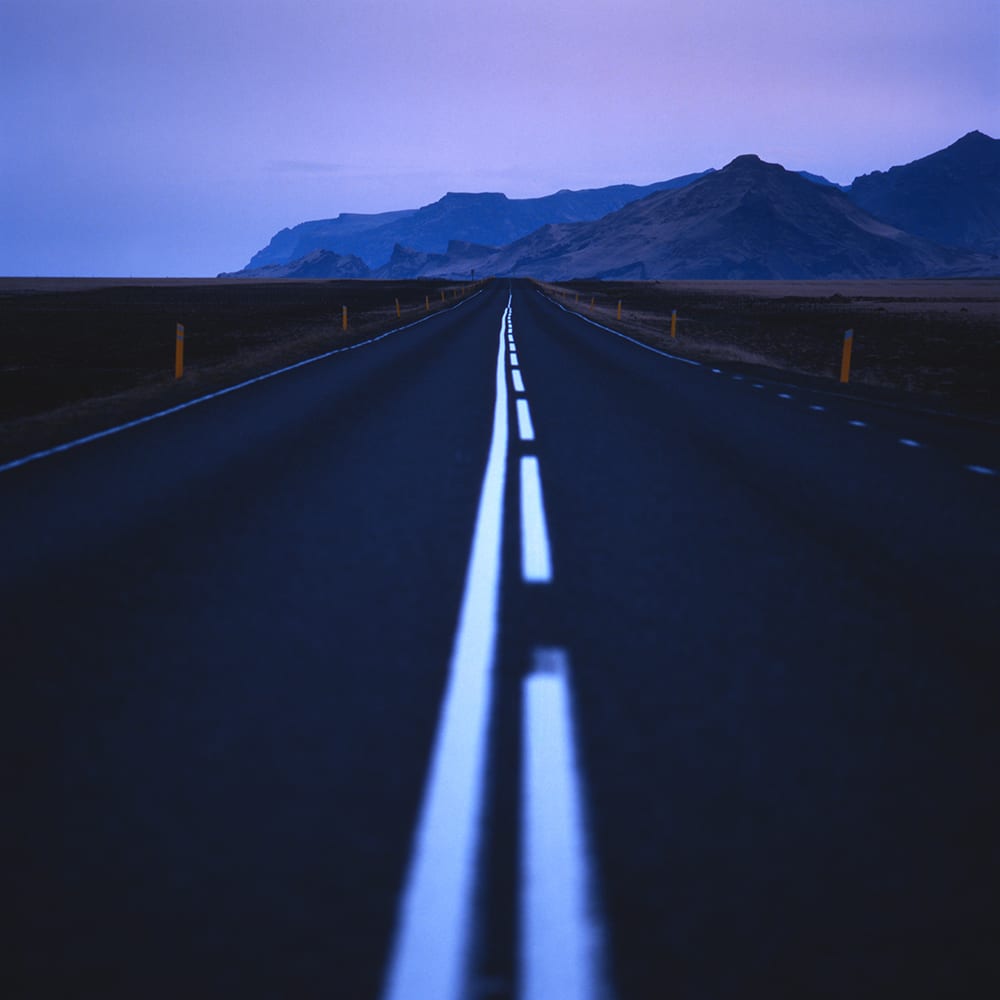 Quiet roads in midnight sun
Quiet roads in midnight sun
In summer, sleep becomes optional, and impressive if you can get enough (but you are reading a guide written by Mr Insomniac himself). In winter, sunlight is a rare guest that you’ll chase down and make sure no early morning lie-ins keep you from making the most of the yellow ball.
Make friends with your headlamp (if you’re an avid photographer, see if you can get a headlamp with a red light option), pack a good eye mask, and download a sleep playlist is my advice.
Northern Light fans, winter darkness is your best friend, and my top tip is to make sure you’re out checking the skies around 11pm, which for some reason seems to stoke the green lady into action if the substorms play ball.
Midnight hikers, summer is your time to shine. There’s no need to rush through the day and plan to the whims of the sun, because he never goes away even when you want him to (I’m sure we all know some people like that). If you can stay up for the anti-social hours, then the hikes and attraction visits are usually that extra special.
The Best Time for Campervan Travel in Iceland
Choosing when to hit the road in Iceland is like picking your favourite ice cream flavour at a shop that only sells weird seasonal specials. There’s no wrong answer, but you’ll definitely have a different experience depending on when you go.
Some months offer the chance to drive through valleys of purple lupines under a midnight sun, while others gift you a camper-side light show courtesy of Miss Aurora herself. Your plans might bend with the wind (literally), but that’s where the beauty lies. Each season gives you front-row seats to Iceland’s ever-changing mood swings.
Weather-Friendly Months for Life on the Road

Late May to early September is usually perfect for campervan travel.
Campsites are open, roads are passable, and you won’t freeze while brushing your teeth at a waterfall, glacier, national park, supposedly dormant volcano, you name it.
Shoulder months like April and October are solid choices for fewer crowds and reduced prices. Just check road conditions before venturing into the Highlands, particularly in terms of water levels for any of the river crossings you may need to drive through.
Pros and Cons of Each Season in a Camper
Summer: It’s light all day, everything that Iceland has is open (except the skiing spots), but you might need to battle for space at the communal campsite kitchens, and sometimes campsites can be full during this peak season.
Winter: Northern Lights viewings are awesome, there’s fewer people, also there’s a lot more cheaper prices on everything from campers to restaurants, but it is a lot colder and the weather can get wild.
Spring and Autumn: Full of shoulder season quieter crowds, but with a balance of light, darkness, and Northern Lights. It’s also the cheapest time to visit on average, as these are the low seasons for tourism in Iceland, and there is always the chance of experiencing snow and sun in one day, which is a cocktail of odd, fun, and memorable. It’s the weather’s version of a midlife crisis.
Why Iceland’s Weather Makes a Campervan Trip Ideal

Hotels? Pfft. They’re rigid, expensive, and they don’t let you sleep next to anything that exciting. So, unless you have your heart set on extortionate prices, less flexibility, and sombre hotel breakfast buffets, I’d suggest you test out a campervan journey
Your campervan is your rolling shelter from the storm, your instant hot cocoa hut, your front-row seat to Northern Lights chases, and provides you the opportunity to wake up next to some of the most incredible scenery on the planet.
It turns Iceland’s unpredictable weather into a proper experience.
Road Tripping Through the Weather

Let’s be honest, the weather in Iceland isn’t going to roll out a red carpet for your road trip.
It will, however, throw in a few surprise fireworks: maybe a hailstorm over a lava field or a sunset that looks like someone lit the sky on fire (I regularly see blood red sunsets on late night walks in June, which are spectacular).
Travelling by campervan is your golden ticket to chasing better skies, sheltering from the odd sideways rain event (you’ll most likely experience this at least once), and waking up with a view that belongs in a cinematic drone shot (one that hasn’t been murdered by Seljalandsfoss).
With a little prep, the road becomes not just part of the journey, but part of the show (no, I’m not Katy Perry). And a Vanlife trip where getting A to B is dramatically different each day is worth doing on your terms, not in the back of tour guide’s minibus.
Driving Tips for All Seasons
Check the SafeTravel website daily before you even brush your teeth. It’s your lifeline to current road conditions, storm alerts, and those cheeky highland closures that pop up without warning.
If there’s a wind warning, take it seriously. Icelandic gusts have been known to blow over unsuspecting tourists and turn most things that are not tied down into frisbees. To reiterate my point above, park into the wind if possible and use both hands when exiting your vehicle.
What should you do if there’s snow and ice on the roads? Slow everything down. Your journey, your braking, and even your playlist (ABBA deserves to be savoured, not rushed). Although all our campers come fitted with studded tyres in winter, that doesn’t make you impenetrable from road accidents from ice and snow, so please don’t treat this liek Fast and Furious 56 (I assumed they’d done at least 55 by now).
As for F-roads: these rugged highland routes are no joke. You’ll need a 4×4, plenty of fuel, and ideally a travel buddy (for high fives and freak outs). River crossings, steep climbs, and remote terrain are all on the menu. And if you’re not sure? Don’t wing it. Wait it out or reroute. The scenery isn’t going anywhere.
Our seasonal driving guides break it all down by month, region, and weather situation so you can hit the road smart, not stressed.
Where to Camp Based on Weather Forecasts

Follow the weather. Literally. And, I don’t mean like a US storm chaser, but more use your flexibility as your strength when encountering different conditions, and check conditions regularly.
Use the Vedur website like it’s your co-pilot. This isn’t just about dodging rain, it’s about finding clear skies for Northern Lights hunting, avoiding strong gusts when a storm is approaching, and knowing when it’s a Netflix day.
Route changes are part of the fun. If the forecast looks bleak for the South Coast, don’t hesitate to flip your itinerary and head to the North or Westfjords instead. Weather shifts fast, and so can you.
Most campsites in Iceland don’t require advanced booking, so if you’re the spontaneous type, you’ve got an edge. Planning your journey around the sun (or at least avoiding the worst wind) is a perk that only a campervan gives you.
This is why vanlife truly thrives in Iceland, and is way more of an adventure than any form of travel. But, yes, I know…I’m biased!
How to Stay Warm, Dry & Safe in a Campervan
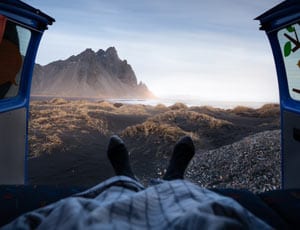
Insulation. Heating. Layers (more layers, more I say!) Snacks. And a bit of strategy.
All of our campervans come with independent heating systems that keep you toasty even when the wind is making the outdoors look like a biblical scene from The Day After Tomorrow.
Insulation in our campers helps retain warmth during frosty nights, while good ventilation keeps condensation in check with all the Jumanji-level monsoons.
Dress like an onion: layers, layers, and more layers (I always write this, but you’ll be surprised at the lack of layers I see under-prepared travellers bringing). Wool thermals, fleece mid-layers, and waterproof outerwear are your non-negotiables. Spare socks will save your soul on at least one occasion (not even a remotely dramatic sentiment). Dry gloves are very important in winter, and if you’re planning any hiking, then for sure keep these with you when you voyage over.
And don’t underestimate the mood-saving power of entertainment: books, cards, a Bluetooth speaker (you can rent one as an add-on), or even a downloaded Spotify playlist (after all, if driving conditions get a little hairy out there, then why not blast some Taylor Swift to calm you down?)
With the right gear and a bit of campervan common sense, you can stay cosy, dry, and smug no matter what the skies throw at you (and, believe me, they will throw something at you).
What to Pack for Iceland’s Wild Weather
You know those packing lists that suggest flip-flops, five pairs of sunglasses, and a featherweight cardigan? In case my rants about layers in the previous 2000 words didn’t resonate, this isn’t that kind of trip.
Packing for Iceland is a bit like prepping for an adventure reality show, only with more waterfalls and fewer camera crews, and sadly, no Bear Grylls (unless, of course, you are Bear Grylls).
Focus your packing on practical, layered, and wind-resistant clothing. Then think again and add a thermal base layer just to be safe (at least pack one to be safe, even if travelling in summer).
What’s the good news, I hear you cry? If you forget something, most Icelandic petrol stations double as surprisingly well-stocked outdoor gear hubs, and towns like Selfoss, Akranes, Vik, and Akureyri will all have options to save you from frostbite (a bit pricey though, I won’t lie).
Year-Round Essentials
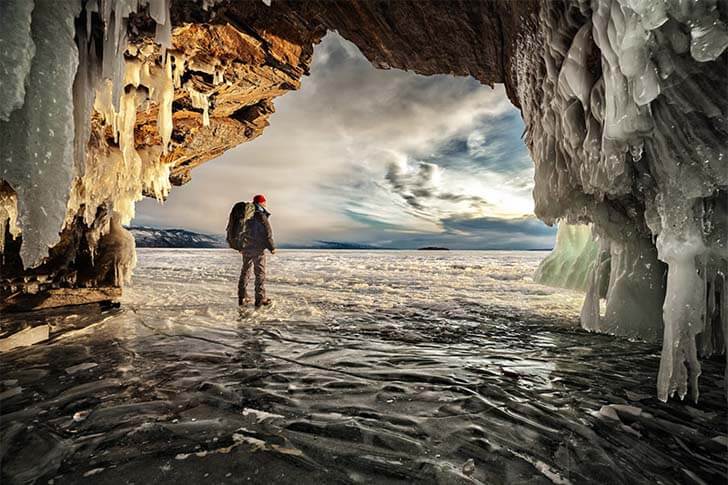
Remember the following list, and you’ll be fine no matter the season. Forget them and you’ll either by cold, freezing, grumpy, or broke when you explore the local shops:
- A waterproof jacket: essential for fending off all kinds of rain and waterfall spray during those misty morning hikes.
- Insulated mid-layers: consider fleece or wool pullovers to trap warmth without sweating like you’re in a sauna. If you have some made of merino wool it’s even better.
- Wool socks and hat: your toes and ears will thank you, especially during breezy evenings or sudden snow flurries. Plus, standing out waiting for the Northern Lights is never warm without dressing prepared.
- Sturdy waterproof hiking boots: for river crossings, muddy campsites, and looking heroic in photos next to lava fields.
- Power bank: because your phone always dies just as the aurora starts to dance. The cold drains lithium batteries in cameras and phones much quicker, so it’s good practice to have a backup or power bank, in my experience.
- Eye mask and earplugs: daylight doesn’t sleep in summer, and neither do some of your snoring campsite neighbours.
- A reusable water bottle: Icelandic tap water is glacier-fresh, free, and tastes better than 90% of bottled brands. Save some money and enjoy this unique convenience.
- Your swimsuit (because Iceland): you never know when you’ll stumble upon a hot spring, a local geothermal swimming pool, or a dare you can’t refuse.
Must-Haves for Campervan Adventures
For the blessed brethren who’ve selected to take a campervan journey in Iceland, firstly, I salute you, and secondly, please check out this list:
- Cooking gear (included in our campervans): everything you need to whip up hot meals from your cosy camper kitchens (extra awesome for roadside midnight snack spots). Pots, pans, plates, and utensils are all packed and ready for you.
- Sleeping bags or duvets (rentable): warm, clean, and fluffier than you’d expect. Whether you’re parked near a volcano or the mouth of a fjord, you’ll sleep snug.
- Portable WiFi (hello Google Maps and TikTok uploads): strong coverage in most regions and ideal for navigation, streaming, and uploading your best puffin photos (free for all our Happy Campers, except EX-category vehicles, which is 10 EUR per day).
- Maps and backup offline directions: because sometimes nature doesn’t care about mobile signal. Trusty old-school backups will save your bacon in remote areas (and help you locate your next rashings).
- Headlamp with extra batteries: for those night-time campsite bathroom trips, late hikes, or just finding your sock that simply vanished.
- Small daypack for hikes: perfect for layering up, snacks, and that thermos of coffee for your stop by one of our 10,000 waterfalls. Choose one with waterproof lining for added ‘I-just-nailed-it-ness’.
Northern Lights & the Weather
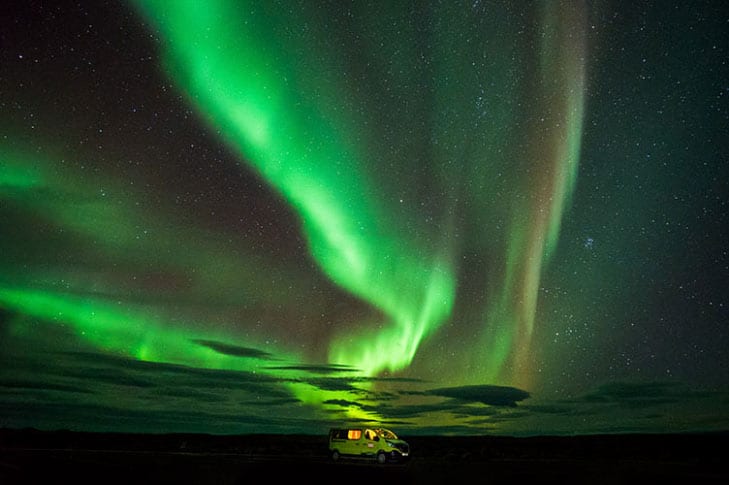
There’s something about Iceland that makes you feel like magic is just around the corner, and when it comes to the Northern Lights, it actually might be.
But as with all things in Iceland, the weather gets a say. Cloud cover, solar activity, and where you park your camper all factor into whether you get a light show or a night of slightly disappointed stargazing, or worse yet, cloud-gazing.
Still, that anticipation, that “will they or won’t they”, is a big part of the thrill and the chase you’ll hear many other travellers talking about at breakfast time. And when they finally dance, it’s a moment that will make you forget how cold your toes are. I’ve seen the Northern Lights over a 1000 times, and each time is different in terms of intensity, movement, colours, and longevity, and it still fills me full of anticipation each time I get my winter gear on in the evenings. After all, it’s not called ‘nature’s greatest show’ for nothing.
Best Conditions for Aurora Spotting
Clear skies. Cold temps. No city lights. A sky that actually feels like cooperating. And of course, a high aurora forecast to make it worth stepping out in your thermals.
But what exactly is the sweet spot? Late September to mid-April, when darkness rules and your chances of a good show increase dramatically. These are the months when Iceland becomes an otherworldly stage for dancing green ribbons across the sky.
The further away from light pollution you are, the better. Remote fjords, small coastal villages like Grundarfjörður in Snæfellsness, by windswept ancient lava fields, or just out of the city under a cloudless sky facing North (remember the Southern Lights are in the other hemisphere, so please look the right way!)
Need help planning your aurora hunt? A member of the team wrote a great Northern Lights spotting guide that breaks it all down, from forecasts to photography tips.
Seeing the Lights from Your Camper
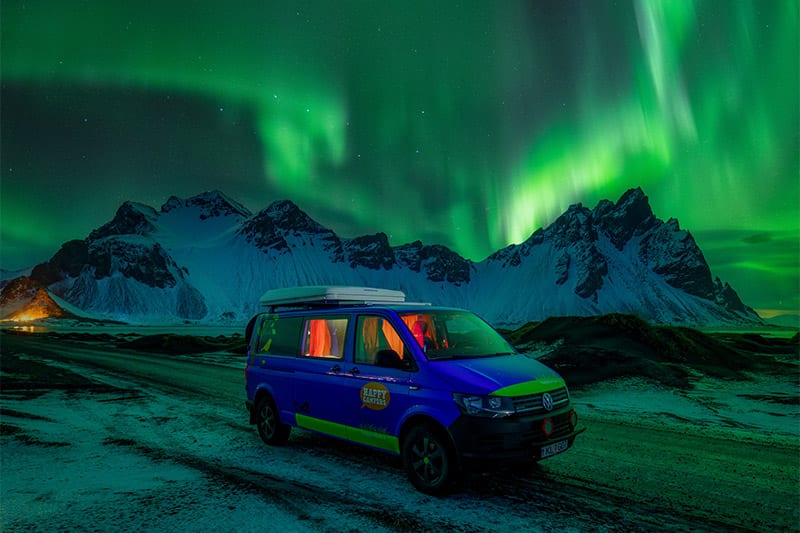
Drive away from light pollution, park somewhere with a wide, unobstructed view of the sky, and settle in. It helps to know the moon phase too. A full moon can wash out weaker aurora activity or make the sky seem extra blue in your photos, while a new moon gives you the best dark backdrop with unobstructed natural conditions for Aurora watching.
Get cosy in your camper. Make hot chocolate, put on some Sigur Rós (or whatever gives you goosebumps), and keep your camera ready with a tripod and long exposure settings.
I can’t give you precise settings for every Aurora as it varies depending on the intensity and speed at which the lights are moving at any given moment. But as a rule of thumb to ensure you get a good enough snap to keep, try the following settings on a DSLR camera on a tripod: Manual mode, widest aperture possible (lowest f-number), shutter speed of 12 seconds, ISO of between 1600 – 3200. This also depends on the lens you have, remember, so if your sole aim is to get some awesome Northern Lights shots, then bring your widest lens.
Stay outside as long as you can, but don’t forget to pop out now and then if you’re warming up inside. The lights can appear suddenly and disappear just as fast.
Just remember: patience is key. Nature doesn’t do appointments. Keep your headlights and other lights off so your eyes are well adjusted. But when the sky lights up, it’ll feel like Iceland just shared one of its best secrets with you.
Iceland Weather FAQs
We get it. You’ve got questions. Iceland’s weather isn’t exactly straightforward, and Google can only tell you so much before you end up in a Reddit thread debating if elves, trolls, or, I guess now, even Trump controls the wind.
This section is for all those nagging little queries that pop up while you’re staring at your campervan window, wondering if the continuous snowfall in June is normal. (It is.)
How Cold Does It Get?
Winter lows hover around -5°C in most areas, with temperatures occasionally plunging to -15°C or lower in the inland and highland regions. It’s the kind of cold that makes your eyebrows frost over if you’re out too long without a hat. That is not me telling you to shave your eyebrows, however.
The wind chill factor often intensifies the bite, making it feel far colder than the thermometer suggests. That’s why you’ll see locals bundled up like Arctic explorers even when the actual temperature doesn’t sound that scary.
In total contrast, summer is refreshingly mild. Temperatures typically sit between 10°C and 15°C in most regions nowadays, with some rare days climbing just over 20°C if the weather gods are feeling generous (all this without a sacrifice to Thor). But don’t be fooled by the sun, a light breeze can still sneak under your jacket if you’re not layered up properly. Add when the weather looks deceitfully nice outside, Icelanders call it Gluggaveður (window weather), which is weather you should only really enjoy from the warmth of your home.
Can You Drive in Snow and Ice?

Yes, with the right vehicle, a bit of preparation, and a healthy respect for Icelandic road signs that will literally puta barrier across roads you are not allowed to venture into.
Driving in snow and ice is absolutely possible, but it’s not something you want to wing with a tiny rental car and zero experience. That’s why during winter all our campervans come fitted with studded tyres, efficient heating systems, and insulation built to handle the chill.
We also recommend checking road conditions daily, avoiding mountain passes during storms, and sticking to main roads unless you’re travelling with a 4×4 and know what you’re doing. Our detailed driving guides cover everything from braking on ice to navigating whiteout conditions with your sanity (and your wing mirrors) intact.
Is the Weather Worse in the Highlands?
Yes.
It’s windier, colder, and usually more dramatic. It has fewer gas stations, more river crossings (there aren’t any others in the country), and an overall vibe of ‘last known photo before the adventure went sideways.’
The weather can change fast, and storms in the Highlands don’t play games. Even in the height of summer, snow can make a surprise cameo, and wind gusts have been known to take hats, tempers, and unsecured camping chairs.
That said, the Highlands are a rare summer experience you won’t find anywhere else. Just make sure you go with a well-equipped 4×4, plenty of fuel, offline maps, and a flexible plan. And always check SafeTravel before heading into the wild so we don’t have to hire Liam Neeson to find you.
Do Weather Warnings Affect Camper Travel?
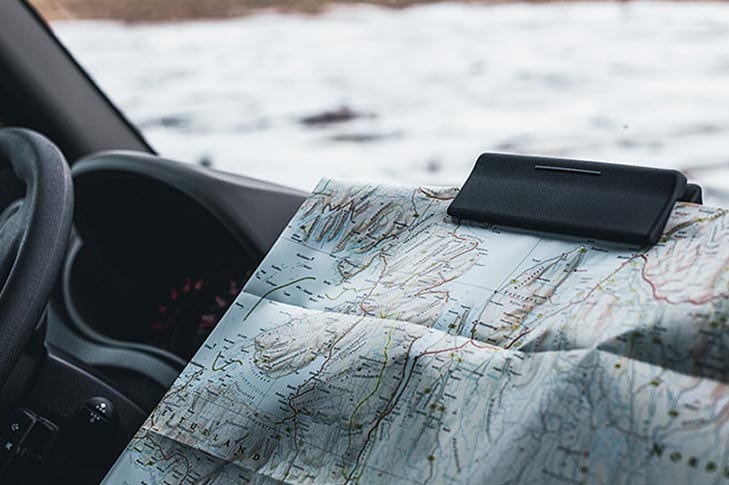
Absolutely. Weather warnings in Iceland aren’t suggestions, they’re red flags you ignore at your own risk. Sudden storms, flooding, landslides, and dangerously high winds can shut down roads, delay travel, and even force campsite closures with little notice.
Always check vedur.is for the latest weather alerts and SafeTravel.is for road conditions and hazard updates. These sites are your best friends on the road and will help you make informed and safe choices each day.
If you see a warning, adapt your plans. Wait out storms at a nearby campsite, reroute to calmer regions, or find an indoor swimming pool and treat yourself to an extra-long soak. Iceland’s weather may be wild, but with a campervan and a flexible mindset, you can turn detours into some of the most memorable moments of your trip.
Conclusion
Iceland’s weather isn’t a problem. It’s part of the adventure. And adventures don’t come without some great, noteworthy moments here and there.
One minute you’re sunbathing by a fjord, the next you’re chasing down your woolly hat as it cartwheels down Reynisfjara.
But with the right campervan, some smart planning, and an appetite for the unknown, you’ll fall in love with every wild, windswept, soggy moment.
Now, grab your layers (sixth and final time I’ll mention this) and your playlist. Now stop thinking about it. Go and book your camper and let’s go and weather some Icelandic weather together.
Back